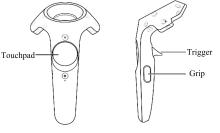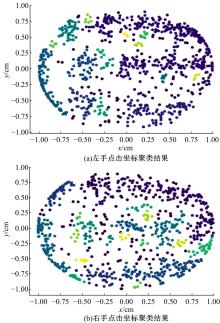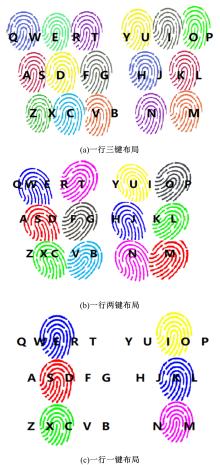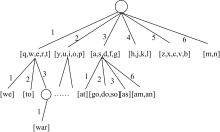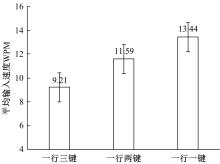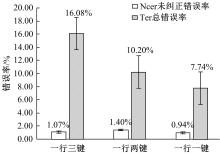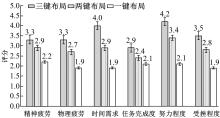吉林大学学报(工学版) ›› 2022, Vol. 52 ›› Issue (8): 1881-1888.doi: 10.13229/j.cnki.jdxbgxb20210159
• 计算机科学与技术 • 上一篇
基于双手键盘的虚拟现实文本输入
- 吉林大学 计算机科学与技术学院,长春 130012
Text input based on two⁃handed keyboard in virtual environment
Gui-he QIN( ),Jun-feng HUANG,Ming-hui SUN(
),Jun-feng HUANG,Ming-hui SUN( )
)
- College of Computer Science and Technology,JiLin University,Changchun 130012,China
摘要:
文字输入是虚拟现实(VR)环境中最常见的交互行为,目前主流的文字输入是通过激光瞄准的方式实现的,然而,现有方法存在诸多弊端,例如效率低、抖动大、扣动扳机容易误触发等,并不能满足VR环境下频繁输入词语的需求。因此,本文提出一种VR环境新型文字输入方式。首先,对键盘进行分区,使用手柄选择字符所在区域,辅以单词消歧算法,实现以单词为单位进行文本输入;其次,对使用者的点击坐标进行聚类分析,做一键多词处理;最后,设计出3种符合用户习惯的键盘布局,并确定出最优的布局。实验结果表明:利用该文本输入方式的最优布局速度高达13.44 WPM(Words per minute),准确率高达92.26%,相比于其他输入方式有较大提高。
中图分类号:
- TP391.9
| 1 | 赵剑, 王柳, 史丽娟, 等. 面向言语康复的多模态人机交互系统[J]. 吉林大学学报: 工学版, 2020, 50(4): 1478-1486. |
| Zhao Jian, Wang Liu, Shi Li-juan, et al. Multimodal human-computer interaction system for speech rehabilitation[J]. Journal of Jilin University(Engineering and Technology Edition), 2020, 50(4): 1478-1486. | |
| 2 | Bowman D A, Wingrave C A, Campbell J M, et al. Using pinch gloves(TM) for both natural and abstract interaction techniques in virtual environments[J/OL]. [2021-03-01]. |
| 3 | Yu D, Fan K, Zhang H, et al. Pizzatext: text entry for virtual reality systems using dual thumbsticks[J]. IEEE Transactions on Visualization and Computer Graphics, 2018, 24(11): 2927-2935. |
| 4 | Kim Y R, Kim G J. Hovr-type: smartphone as a typing interface in vr using hovering[C]∥IEEE International Conference on Consumer Electronics(ICCE), Seoul, Republic of Korea, 2017: 200-203. |
| 5 | Lee Y, Kim G J. Vitty: virtual touch typing interface with added finger buttons[C]∥International Conference on Virtual, Augmented and Mixed Reality, Seoul, Republic of Korea, 2017: 111-119. |
| 6 | Cui W, Zheng J, Lewis B, et al. Hotstrokes: word-gesture shortcuts on a trackpad[C]∥Proceedings of the 2019 CHI Conference on Human Factors in Computing Systems, Glasgow, Scotland UK,2019: 1-13. |
| 7 | Bowman D A, Rhoton C J, Pinho M S. Text input techniques for immersive virtual environments: an empirical comparison[C]∥Proceedings of the Human Factors and Ergonomics Society Annual Meeting, Baltimore, USA, 2002: 2154-2158. |
| 8 | Pick S, Puika A S, Kuhlen T W. Swifter: design and evaluation of a speech-based text input metaphor for immersive virtual environments[C]∥IEEE Symposium on 3D User Interfaces(3DUI), Greenville, USA, 2016: 109-112. |
| 9 | 梁士利, 魏莹, 潘迪, 等. 基于语谱图行投影的特定人二字汉语词汇识别[J]. 吉林大学学报: 工学版, 2017, 47(1): 294-300. |
| Liang Shi-li, Wei Ying, Pan Di, et al. Recognition to specific two words Chinese vocabulary based on projection matrix of spectrogram[J]. Journal of Jilin University(Engineering and Technology Edition), 2017, 47(1): 294-300. | |
| 10 | Wobbrock J O, Myers B A, Aung H H. Writing with a joystick: a comparison of date stamp, selection keyboard, and edgewrite[C]∥Proceedings of Graphics Interface, London, Canada, 2004: 1-8. |
| 11 | MacKenzie I S. KSPC (keystrokes per character) as a characteristic of text entry techniques[C]∥International Conference on Mobile Human-Computer Interaction, Berlin, Heidelberg, 2002: 195-210. |
| 12 | Venolia D, Neiberg F. T-Cube: a fast, self-disclosing pen-based alphabet[C]∥Proceedings of the SIGCHI Conference on Human Factors in Computing Systems, Pisa, Italy, 1994: 265-270. |
| 13 | Zhao S, Dragicevic P, Chignell M, et al. EarPod: eyes-free menu selection using touch input and reactive audio feedback[C]∥Proceedings of the SIGCHI Conference on Human Factors in Computing Systems, California, USA, 2007: 1395-1404. |
| 14 | Benligiray B, Topal C, Akinlar C. SliceType: fast gaze typing with a merging keyboard[J]. Journal on Multimodal User Interfaces, 2019, 13(4): 321-334. |
| 15 | Mottelson A, Larsen C, Lyderik M, et al. Invisiboard: maximizing display and input space with a full screen text entry method for smartwatches[C]∥Proceedings of the 18th International Conference on Human-Computer Interaction with Mobile Devices and Services, Florence, Italy, 2016: 53-59. |
| 16 | Poirier F, Belatar M. Uniwatch: a soft keyboard for text entry on smartwatches using 3 keys watch user-interface and user evaluation[C]∥International Conference on Human-Computer Interaction, Toronto, Canada, 2016: 341-349. |
| 17 | Jiang H, Weng D. HiPad: text entry for head-mounted displays using circular touchpad[C]∥IEEE Conference on Virtual Reality and 3D User Interfaces(VR), Atlanta, United States, 2020: 692-703. |
| 18 | MacKenzie I S. Fitts' law as a research and design tool in human-computer interaction[J]. Human-computer Interaction, 1992, 7(1): 91-139. |
| 19 | Vertanen K, Kristensson P O. Complementing text entry evaluations with a composition task[J]. ACM Transactions on Computer-Human Interaction, 2014, 21(2): 2555691. |
| 20 | Levenshtein V I. Binary codes capable of correcting deletions, insertions, and reversals[J]. Soviet Physics Doklady, 1966, 10(8): 707-710. |
| [1] | 白天,徐明蔚,刘思铭,张佶安,王喆. 基于深度神经网络的诉辩文本争议焦点识别[J]. 吉林大学学报(工学版), 2022, 52(8): 1872-1880. |
| [2] | 曲福恒,丁天雨,陆洋,杨勇,胡雅婷. 基于邻域相似性的图像码字快速搜索算法[J]. 吉林大学学报(工学版), 2022, 52(8): 1865-1871. |
| [3] | 王震,盖孟,许恒硕. 基于虚拟现实技术的三维场景图像表面重建算法[J]. 吉林大学学报(工学版), 2022, 52(7): 1620-1625. |
| [4] | 刘铭,杨雨航,邹松霖,肖志成,张永刚. 增强边缘检测图像算法在多书识别中的应用[J]. 吉林大学学报(工学版), 2022, 52(4): 891-896. |
| [5] | 方世敏. 基于频繁模式树的多来源数据选择性集成算法[J]. 吉林大学学报(工学版), 2022, 52(4): 885-890. |
| [6] | 王生生,陈境宇,卢奕南. 基于联邦学习和区块链的新冠肺炎胸部CT图像分割[J]. 吉林大学学报(工学版), 2021, 51(6): 2164-2173. |
| [7] | 李学勇,赵仲秋,张春松,路长厚. 基于有限元的人体⁃机械手交互力计算方法[J]. 吉林大学学报(工学版), 2021, 51(5): 1612-1619. |
| [8] | 赵宏伟,张子健,李蛟,张媛,胡黄水,臧雪柏. 基于查询树的双向分段防碰撞算法[J]. 吉林大学学报(工学版), 2021, 51(5): 1830-1837. |
| [9] | 曹洁,屈雪,李晓旭. 基于滑动特征向量的小样本图像分类方法[J]. 吉林大学学报(工学版), 2021, 51(5): 1785-1791. |
| [10] | 王春波,底晓强. 基于标签分类的云数据完整性验证审计方案[J]. 吉林大学学报(工学版), 2021, 51(4): 1364-1369. |
| [11] | 钱榕,张茹,张克君,金鑫,葛诗靓,江晟. 融合全局和局部特征的胶囊图神经网络[J]. 吉林大学学报(工学版), 2021, 51(3): 1048-1054. |
| [12] | 周炳海,吴琼. 基于多目标的机器人装配线平衡算法[J]. 吉林大学学报(工学版), 2021, 51(2): 720-727. |
| [13] | 许骞艺,秦贵和,孙铭会,孟诚训. 基于改进的ResNeSt驾驶员头部状态分类算法[J]. 吉林大学学报(工学版), 2021, 51(2): 704-711. |
| [14] | 宋元,周丹媛,石文昌. 增强OpenStack Swift云存储系统安全功能的方法[J]. 吉林大学学报(工学版), 2021, 51(1): 314-322. |
| [15] | 车翔玖,董有政. 基于多尺度信息融合的图像识别改进算法[J]. 吉林大学学报(工学版), 2020, 50(5): 1747-1754. |
|
||
